Devon
Explore hidden histories, historic photos, and things you never knew about Devon from the collections and archives of Historic England.
Discover your local listed buildings and places
Introducing some of Devon's most historic sites, included in the National Heritage List for England. Some of these captions have been summarised by AI. Click through for the official List entry. Skip this section and go to place by numbers
Council House and former Civic Centre
Plymouth
Plymouth former Civic Centre is a particularly complete and coherent civic centre which compares well with others of its date including Newcastle Civic Centre, Newcastle-upon-Tyne (listed...
Tavistock Abbey
Tavistock
Tavistock Abbey, founded by Ordulf in 974, played a vital role in medieval society as a center for religion, wealth, and community, surviving until the Dissolution of 1539.
Berry Head Fort and battery and Hardy's Head Battery
Brixham
Berry Head Fort and Hardy's Head Battery exemplify Napoleonic defenses on England's south coast, built to counter French invasion threats in the late 18th and early 19th centuries.
A la Ronde and The Point-in-View
Exmouth
Developed in the late C18 and early C19 with further alterations in the late C19, A La Ronde and the associated grounds of the chapel, Manse and almshouses known as The Point in View, form a...
Plympton Castle
Plymouth
Plympton Castle, a motte and bailey castle with shell keep, was vital during Britain’s Norman era, notable for its strategic role in King Stephen's Civil War and rare architectural design.
Northam Chain Home Radar Station
Northam
Second World War radar station, built 1941 and ceased operating in 1944The site includes two transmitter blocks, two receiver blocks, the bases of two receiver tower and four transmitter...
Woodbury Castle
Woodbury
Woodbury Castle is a well-preserved ancient hillfort used from the Iron Age, known for its massive earthworks, displaying social mobilization, and being a redistributive center.
Culmstock Beacon
Culmstock
Culmstock Beacon, in the Blackdown Hills, Devon, was a medieval signal to warn of invasion, constructed in the 16th century.
Blackdown Rings prehistoric hillfort and medieval castle
Loddiswell
The Blackdown Rings site includes well-preserved prehistoric hillforts and medieval ringworks with strategic historical significance, showcasing defensive structures and continuous land use...
Gunpowder factory at Powder Mills, a partially enclosed s…
Dartmoor Forest
The gunpowder factory at Powder Mills is a well-preserved 19th-century site with intact buildings, machinery remnants, and archaeological significance, highlighting Dartmoor's historic...
Plymouth Castle (remains of)
Plymouth
The remnants of Plymouth Castle indicate it was likely built for defense against naval attacks, rather than as a noble residence or royal castle.
Castle Dyke
Ashcombe
Castle Dyke is a slight univallate hillfort on Little Haldon Hill. It offers insights into community transitions from the Bronze to Iron Age and generally survives well.
Oxton House
Kenton
Oxton House, a picturesque late 18th-century estate developed by Rev John Swete, features gardens and pleasure grounds with historical literary connections and significant cultural...
Clyst St Mary Bridge and causeway
Clyst St. George
Clyst St Mary Bridge, a medieval multi-span bridge in Devon, features 13th-14th century construction details and was pivotal in the 1549 Western Prayer Book Rebellion.
Wood House
South Tawton
Wood House features early 20th-century formal gardens and parkland designed by Thomas Mawson.
H M Prison Dartmoor: F and G Wings
Dartmoor Forest
A prison wing of 1809 remodelled before 1885 by Colonel AB McHardy, extended with a six storey prison wing between 1901 and 1904/5 to designs by Alten Beamish, with later alterations.
Barnstaple Castle
Barnstaple
Barnstaple Castle is a Norman motte and bailey structure known for its archaeological significance, including unexcavated Saxon burials and insights into Norman fortification techniques.
Oliver Buildings at the Former Shapland and Petter Factory
Barnstaple
The former offices and showroom, and the surviving part of the furniture factory of Shapland and Petter, built in 1888 to designs by local architect William Clement Oliver (1832-1913),...
Bicton
Bicton
Bicton, developed from the 11th century, features 18th and 19th-century gardens, parkland, and arboretum, with input from W S Gilpin and J C Loudon, among others.
Watcombe Park and Brunel Manor
Torquay
Isambard Kingdom Brunel and head gardener Alexander Forsyth designed Watcombe Park in the mid-19th century, incorporating ornamental landscapes and public gardens.
Eight Second World War concrete replica landing craft str…
Braunton
Eight concrete replica landing craft structures, built in 1943 for training in preparation for D-Day.
Hazeldon House
Tavistock
A smaller country house, built in 1833-1834 in Tudor Gothic style, to designs by George Wightwick (1802-1872), for CV Bridgman, Esq.
Court Castle
Winkleigh
Court Castle is a medieval motte and bailey castle in Winkleigh, Devon, significant for its Norman military architecture and proximity to another castle in the village.
Former Barclays Bank Building
Plymouth
The former Barclays Bank building, constructed in 1950-2 to designs by Curtis Green, Son and Lloyd; converted and extended vertically in 2005-7 by Architects Design Group.
Chambered tomb, 630m north west of Elberry Farm
Paignton
The chambered tomb near Elberry Farm is a rare Neolithic funerary monument in Devon.
Cadbury Castle
Cadbury
Cadbury Castle, a slight univallate hillfort in Devon, is nationally important for understanding Late Bronze to Early Iron Age communities and has seen Roman and later reoccupations.
Dartington Hall
Dartington
Early and mid-C20 gardens principally designed by H Avray Tipping, Beatrix Farrand and Percy Cane, with a walled medieval deer park and a wider early-C20 landscape surrounding early 1930s...
Second World War bombing range target indicator and obser…
Georgeham
Second World War bombing range target indicator and observation post overlooking Putsborough Sands and Morte Bay, built in around 1942.
Sydenham House
Marystow
Sydenham House, built by Sir Thomas Wise, reflects Devon's historical transitions from the Wise family to Tremaynes, serving varied purposes over centuries, including wartime school use and...
The medieval Exe Bridge, St Edmund's Church, and medieval…
Exeter
The Old Exe Bridge is a well-preserved medieval bridge from around 1200, featuring St Edmund's Church and medieval tenements, showcasing historical masonry and early construction techniques.
St Michael's Chapel, Chapel Hill
Torquay
St Michael's Chapel, located on Chapel Hill, is a 14th-century medieval chapel notable for its intact medieval fabric and unique setting, offering insights into medieval religious practices.
Efford Fort and Efford Emplacement
Plymouth
Efford Fort played a key role in Britain's defense during the 19th century, forming part of Plymouth's extensive fortification system to protect against French invasion threats.
Cranmore Castle
Tiverton
Cranmore Castle is a significant Iron Age hillfort, notable for its complete defensive circuit, impressive ramparts, and archaeological findings, offering insights into ancient societal...
Farway Castle earthwork enclosure
Farway
Farway Castle, an Iron Age farmstead in Devon, is a rare earthwork enclosure with significant archaeological value due to its proximity to a major Bronze Age cemetery.
Royal Bank of Scotland
Plymouth
The Royal Bank of Scotland, Plymouth, built in 1956-1959 for the National Provincial Bank by the Bank's architects' department, with B C Sherren as Chief Architect.
The Hoe
Plymouth
The Hoe, a historic recreational site in Plymouth, dates back to medieval times. It features public monuments, promenades, and an iconic lighthouse, reflecting its cultural importance.
Old church (remains of)
Bicton
The 15th-century church near St Mary’s in Bicton Park features a tower, historic family associations, and exemplifies architectural folly trends with its adaptation by architect A W N Pugin.
Luscombe Castle
Dawlish
Luscombe Castle is a significant early 19th-century estate designed by John Nash and landscaped by Humphry Repton, known for its picturesque style and historical gardens.
Explore more
Search for more listed placesDevon through time
This timeline shows the first period of use for buildings and places on the National Heritage List for England, just one of the details recorded for every list entry. Click around to see how Devon changes over time. Skip this section and go to aerial photos
Prehistoric Before AD 43
Prehistory covers a million years of human occupation before the Roman invasion, from hunter-gatherers of several human species, including Neanderthals, to more recent herders and farmers. It was a time of developing technologies and belief systems, involving contact with and migration from Europe, all reflected in the variety of artefact and monument types characteristic of particular prehistoric periods.
Roman AD 43 to AD 410
Britain was invaded by four legions of the Roman army in AD 43, who relatively rapidly conquered England from landing points in Kent. Parts of Wales and Scotland soon followed.
Roman culture brought urbanism, monumental buildings, wide-ranging religious beliefs, writing, and strong social hierarchy. The Roman administrative system was withdrawn in AD 410.
Early medieval AD 410 to AD 1066
This period, often associated in England with Anglo-Saxons and Vikings, saw a reduction in urban living from the Roman period and increased migration from northern Europe.
Traces of this period can be found in cemeteries, particularly in artefacts and in some of the very early churches, as this period also saw the growth of Christianity in Britain.
Medieval AD 1066 to AD 1540
This period, sometimes known as the Middle Ages, began with the Norman invasion in AD 1066. It saw a significant rise in military and defensive buildings such as castles and earthworks, as well as religious houses dominating a largely agricultural landscape.
The monarchy and Church dominated the period, which also saw the break with the Roman Catholic Church and the English reformation.
Post medieval AD 1540 to AD 1901
The Post-Medieval period brought seismic changes to life in England, with religious reformation leading to the democratization of worship and the destruction of hundreds of religious houses.
In parallel, there was a huge expansion of scientific study and enlightenment that permanently altered the nation's social structure and landscape. Industrialization and mass production lead to wider global trade, emigration, and immigration.
20th century AD 1901 to AD 2000
The 20th century saw an incredible expansion of England's transport networks, with suburban growth shadowing rapid infrastructural expansion. The establishment of state schools, hospitals, and modern technical colleges, with new architectural styles, radically changed the appearance of towns and cities.
Two catastrophic world wars and the 1918 pandemic also brought unprecedented change, altering England's built environment and social structures forever.
Prehistoric Before AD 43
Prehistory covers a million years of human occupation before the Roman invasion, from hunter-gatherers of several human species, including Neanderthals, to more recent herders and farmers. It was a time of developing technologies and belief systems, involving contact with and migration from Europe, all reflected in the variety of artefact and monument types characteristic of particular prehistoric periods.
Roman AD 43 to AD 410
Britain was invaded by four legions of the Roman army in AD 43, who relatively rapidly conquered England from landing points in Kent. Parts of Wales and Scotland soon followed.
Roman culture brought urbanism, monumental buildings, wide-ranging religious beliefs, writing, and strong social hierarchy. The Roman administrative system was withdrawn in AD 410.
Early medieval AD 410 to AD 1066
This period, often associated in England with Anglo-Saxons and Vikings, saw a reduction in urban living from the Roman period and increased migration from northern Europe.
Traces of this period can be found in cemeteries, particularly in artefacts and in some of the very early churches, as this period also saw the growth of Christianity in Britain.
Medieval AD 1066 to AD 1540
This period, sometimes known as the Middle Ages, began with the Norman invasion in AD 1066. It saw a significant rise in military and defensive buildings such as castles and earthworks, as well as religious houses dominating a largely agricultural landscape.
The monarchy and Church dominated the period, which also saw the break with the Roman Catholic Church and the English reformation.
Post medieval AD 1540 to AD 1901
The Post-Medieval period brought seismic changes to life in England, with religious reformation leading to the democratization of worship and the destruction of hundreds of religious houses.
In parallel, there was a huge expansion of scientific study and enlightenment that permanently altered the nation's social structure and landscape. Industrialization and mass production lead to wider global trade, emigration, and immigration.
20th century AD 1901 to AD 2000
The 20th century saw an incredible expansion of England's transport networks, with suburban growth shadowing rapid infrastructural expansion. The establishment of state schools, hospitals, and modern technical colleges, with new architectural styles, radically changed the appearance of towns and cities.
Two catastrophic world wars and the 1918 pandemic also brought unprecedented change, altering England's built environment and social structures forever.
Aerial photos of Devon
Aerial photography helps reveal secrets of England's changing landscapes that are impossible to see from the ground. Skip this section and go to archive images
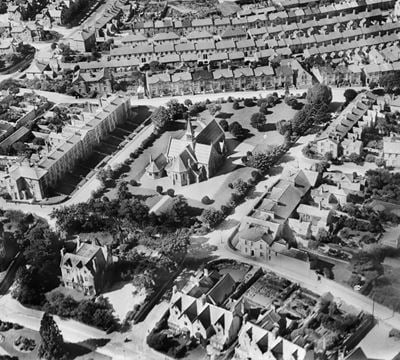
Newton Abbot
St Paul's Church, Newton Abbot, 1928

Newton Abbot
Courtenay Park and the town centre, Newton Abbot, 1932
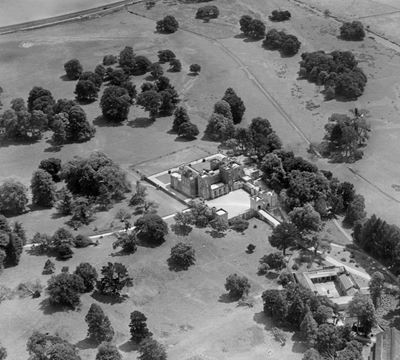
Powderham
Powderham Castle, Powderham, 1930
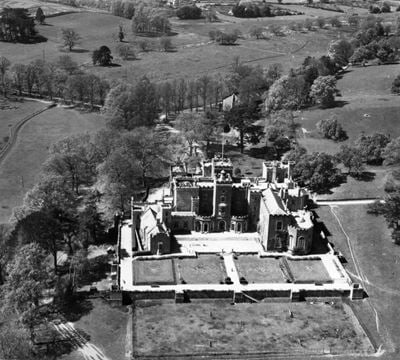
Powderham
Powderham Castle, Powderham, 1948
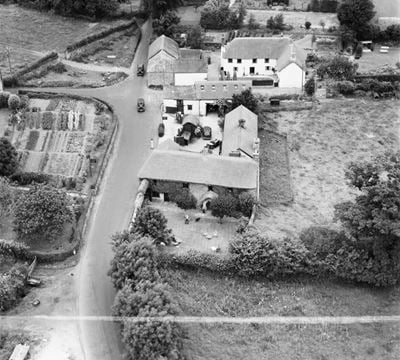
Easton
Easton Court Hotel, Easton, 1950
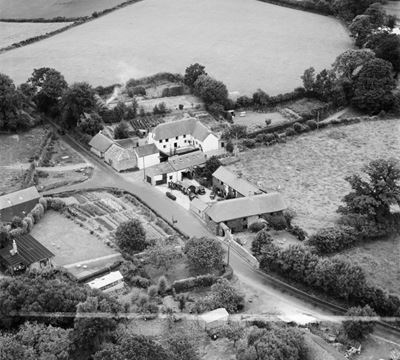
Easton
Easton Court Hotel, Easton, 1950
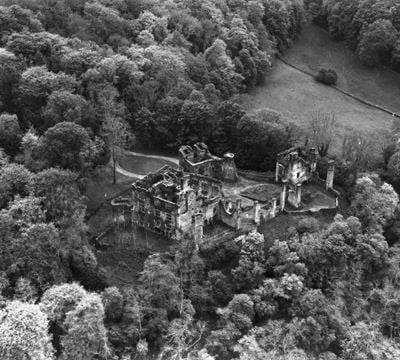
Berry Pomeroy
Berry Pomeroy Castle, Berry Pomeroy, 1947

Berry Pomeroy
Berry Pomeroy Castle, Berry Pomeroy, 1947
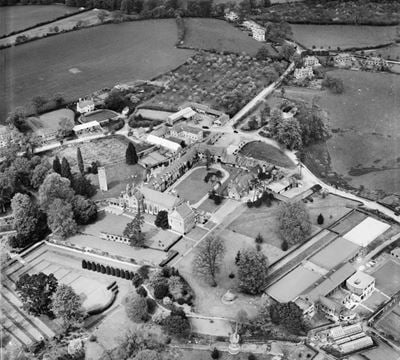
Dartington
Dartington Hall, Dartington, 1947

Dartington
Dartington Hall, Dartington, 1947
Devon in the Historic England Archive
The Historic England Archive cares for over 15 million images, dating from the 1850s to the present day. Discover stunning images of Devon's past. Skip this section and go to stories about heritage
Charles George Harper Collection
Revelstoke, South Hams, Devon
Date created: 1892 - 1933
Looking through trees towards the ruins of St Peter's Church
Eric de Mare
Bigbury, South Hams, Devon
Date created: 1945 - 1980
Interior view of St Lawrence's Church in Bigbury showing the eagle lectern.
John Gay Collection: Modern Architects
Tamerton Foliot, City Of Plymouth, City Of Plymouth
Date created: 1967 - 1975
The modern housing estate at Tamerton Foliot, formerly a small village to the north of Plymouth, but now a suburb of the city
John Gay Collection: Rural Life
South Hams, Devon
Date created: 1955 - 1965
A view of a herd of cows in a large field, with a misty rural landscape of fields and a large hill in the background. Photographed near Newton Ferrers
John Gay Collection: Miscellaneous
Torbay
Date created: 1957
An informal portrait of 70 year old William John Harris of Brixham, wearing a flat cap and wool jacket, and in conversation whilst seated on a wooden...
John Gay Collection: Counties
South Hams, Devon
Date created: 1950s
Children crabbing at low water on the Newton Voss, Devon, a causeway across Newton Creek
John Laing Collection
South Hams, Devon
Date created: 02 Jun 1956
People disembarking from the Dartmouth Higher Ferry at Britannia Crossing on the east bank of the River Dart during a Laing staff day trip to Paignton
London, Midland and Scottish Railway Company
Slapton Village, South Hams, Devon
Date created: 1884
A general view looking towards the village of Slapton with the West Tower of the Collegiate Chantry of St Mary in the foreground
Nigel Temple Collection of Postcards of Parks and Gardens
The Hoe, City Of Plymouth, City Of Plymouth
Date created: 1900 - 1920
GENERAL VIEW OF THE SLOPES OF PLYMOUTH HOE
Margaret Tomlinson Collection
South Hams, Devon
Date created: 01 Jan 1944 - 17 Jul 1944
The bombed ruins of St Andrew's Church seen from the south-east
Walter Scott
Torcross, South Hams, Devon
Date created: 1947
A view looking north along Slapton Sands, with the Start Bay Inn in the foreground and people buying refreshments from a kiosk
Stories about heritage in your local area
Historic England publishes news, blogs, research, videos, and podcasts celebrating England's rich heritage. Discover the stories we have about Devon. Skip this section and go to education
Historic England Acquires World-Class Collection Featuring Earliest and Finest Photographs of England
Mentions Devon
An important collection of some of the finest earliest landscape photography of England has been added to the Historic England Archive.
30 New Projects Explore England’s Rural and CoastalWorking-Class Heritage
Mentions Devon
Funded by Historic England's Everyday Heritage grants programme, these projects will explore untold stories and celebrate the heart of our history.
A Brief Introduction to the History of the Railway in England
Mentions The Starcross Pumping House
Discover when the first steam train was invented in England, and when the world's first public railway opened in Stockton and Darlington in 1825.
What Happened After the End of Roman Rule in Britain?
Mentions Cadbury Castle
After the fall of the Roman Empire in Britain around AD 410, many towns declined, industries ceased, and the Roman army left England's shores.
The Life and Work of John Smeaton, the ‘Father of Civil Engineering’
Mentions Smeaton's Tower
Discover the remarkable feats of engineering by British civil engineer John Smeaton.
What Is the Oldest Building in England?
From the oldest church to archaeological remains, here are the contenders for England's oldest building.
Narrative Structures: England’s Literary History in 11 Places
Mentions Greenway House
Discover the historic sites in England where famous writers found their inspiration.
Ghost Signs: Spooky Remains of a Hidden Past
Mentions 6, The Barbican
Once you’re on the look out for ghost signs, you’ll find they are frequently hidden in plain sight.
5 Things to Know About Coronations
Mentions Coronation Boathouse and adjacent store building
Discover the history and heritage behind the ancient English coronation ceremony.
The Buildings of Philanthropist John Passmore Edwards
Mentions Adult Education Centre and Library
Over 70 buildings were constructed in 14 years, including libraries, literary institutes and art galleries.
10 Historic Sites That Tell the Story of Katherine of Aragon in England
Mentions Church of St Andrew
Explore the significance of places visited or lived in by Katherine of Aragon, the first wife of Henry VIII.
Women Architects Who Helped Shape England
Mentions A La Ronde
Women have always influenced domestic design but it wasn’t until 1898 that the first female architect was admitted to the Royal Institute of British...
Secret Worlds Hidden Beneath Surface Structures
Mentions Octagonal Ventilation Shaft About 140 Metres South of Canonteign Barton
Unusual and often puzzling surface structures can be found in our cities, towns and countryside.
7 Historic Urban Parks and Gardens To Improve Your Wellbeing
Mentions Devonport Park
Parks and green spaces are vital for our mental and physical health.
Mentions Devon
Rachel Thompson worked with mason Charlie Smith on conserving the fog battery station complex on remote Lundy Island off the coast of Devon in 2016.
Conserving the Fog Battery Station on Lundy Island
Rachel Thompson worked with mason Charlie Smith on conserving the fog battery station complex on remote Lundy Island off the coast of Devon in 2016.
Mentions Devon
Fiona Hailstone has led a team of volunteers in a complex project to bring Killerton Park back to life, restoring deer pales and monuments and...
Bringing Killerton Park to Life
Fiona Hailstone has led a team of volunteers in a complex project to bring Killerton Park back to life, restoring deer pales and monuments and researching parkland boundaries.
Mentions Devon
Shipwrecks have been a source of inspiration to English writers, artists and scholars for centuries, from Shakespeare to Enid Blyton, whose Famous...
3 Historic Shipwrecks in Devon
Shipwrecks have been a source of inspiration to English writers, artists and scholars for centuries, from Shakespeare to Enid Blyton, whose Famous Five spent a whole summer exploring a fictional Cornish wreck.
Celebrating the Harold Wingham Collection Through Active Participation
Mentions Devon
A collaborative project remembers the work of Harold Wingham, an unsung hero of aerial photography.
Historic England Reveals 17 Historic Sites Across England With Significant Development Potential
Mentions Devon
Underused historic buildings across England could be given new life through a major investment initiative launched by Historic England.
Landscape Histories for Landscape Futures
Mentions Devon
Exploring the evolving role of archaeology in large-scale nature recovery projects.
From Pixels to Pasts: Uncovering the Value of Shipwrecks Through Social Media
Mentions Devon
A new study examines how social media platforms can illuminate the social values of shipwreck heritage.
First Phase of Major Roof Repairs Complete at King Arthur's Great Halls, Tintagel
Mentions Devon
A Historic England grant has supported the first significant repairs in 90 years to Grade II* listed King Arthur's Great Halls in Tintagel, Cornwall.
Historic England Acquires World-Class Collection Featuring Earliest and Finest Photographs of England
Mentions Devon
An important collection of some of the finest earliest landscape photography of England has been added to the Historic England Archive.
Volunteers Help Care for Local Archaeology in Torridge, North Devon
Mentions Devon
Several new projects are underway as part of a scheme to protect and celebrate the remarkable archaeology of the Torridge district in north Devon.
30 New Projects Explore England’s Rural and CoastalWorking-Class Heritage
Mentions Devon
Funded by Historic England's Everyday Heritage grants programme, these projects will explore untold stories and celebrate the heart of our history.
The Commercial Buildings of Redruth, Cornwall
Mentions Devon
Research into the historic commercial buildings of Redruth to inform the work of the High Street Heritage Action Zone in the town..
Historic Watercourses and Climate Change: Mapping the History of Rivers and Floodplains
Mentions Devon
How a GIS tool can be used to gather information to manage historic watercourses and increase their resilience to climate change.
Malt Kilns and Malthouses
Mentions Devon
A new book tells the important story of how maltings evolved in England and looks at their future use.
Repaired Farm Building at Lupton House in Devon to Have a New Community Use
Mentions Stables and Other Ancillary Buildings Immediately North West of Gramercy Hall School, Gramercy Hall School, Lupton House, Lupton Park
Lupton Trust to progress a community garden project in the historic farmstead following recent repairs to the so-called calves' house.
Devon's social history through photos
Over 10,000 images from the Historic England Archive have been specially selected and re-captioned for teachers, students, and anyone who wants to learn more about their local area. Skip this section and go to grant-aided places
Wynard's Hospital, Magdalen Street, Exeter, Devon
Period: Medieval (Middle Ages) (1066 - 1484)
These almshouses were founded in 1435. They were rebuilt in the 17th century and altered by Sir William Kennedy in the late 18th century.
Wynard's Hospital, Magdalen Street, Exeter, Devon
Windy Cross, South Street, Great Torrington, Devon
Period: Victorian (1837 - 1901)
There is a 19th century former pump house at the west end of South Street. The Windy Cross sits on top of it.
Windy Cross, South Street, Great Torrington, Devon
Wheal Maria Cottages, 1-20, Gulworthy, Devon
Period: Victorian (1837 - 1901)
This row of 10 paired houses was built around 1870.
Western Morning News Offices, Brent Road, Derriford, Plymouth
Period: 1990s (1990 - 1999)
The distinctive offices of the Western Morning News in Brent Road in Derriford.
Western Morning News Offices, Brent Road, Derriford, Plymouth
Western Lodge Hospital, Western Road, Crediton, Devon
Period: Victorian (1837 - 1901)
This building was originally Crediton Union workhouse. It was built in 1836-7 at a site to the west of Crediton. It was designed by Sampson Kempthorne.
Western Lodge Hospital, Western Road, Crediton, Devon
Wedding reception at Torquay, Devon
Period: Edwardian (1902 - 1913)
A wedding photograph showing the groom, J H.Morrell of the Oxford brewing family, and his bride, J Denton, at their reception in Torquay.
Wedding reception at Torquay, Devon
Watching the Fleet, Paignton, Devon
Period: Victorian (1837 - 1901)
Seven men in different costumes and from different walks of life watch warships in the harbour.
View of Clovelly, Devon
Period: Edwardian (1902 - 1913)
A view taken from the beach looking inland towards the building rising from the cliffs.
View of Clovelly, Devon
Visit grant-aided places near you
These places and buildings have been helped by Historic England's financial grants. Find local heritage in your neighbourhood that you never knew existed! Please note that opening times may vary. Skip this section and go to related locations
Dunkeswell Abbey, Dunkeswell, Devon
Dunkeswell Abbey, founded in 1201, was a Cistercian monastery that still boasts extensive archaeological remains.
St Michael's Chapel, Chapel Hill, Torre, Devon
St. Michael's Chapel, located on Chapel Hill, is a medieval stone chapel with a vaulted roof.
The Elizabethan House Museum, New Street, Plymouth
Elizabethan House was built in around 1600 and was extensively restored between 2017 and 2020 as part of the Mayflower 400 celebrations.
Discover more
Ready for more local stories? Take a look at these other places nearby


